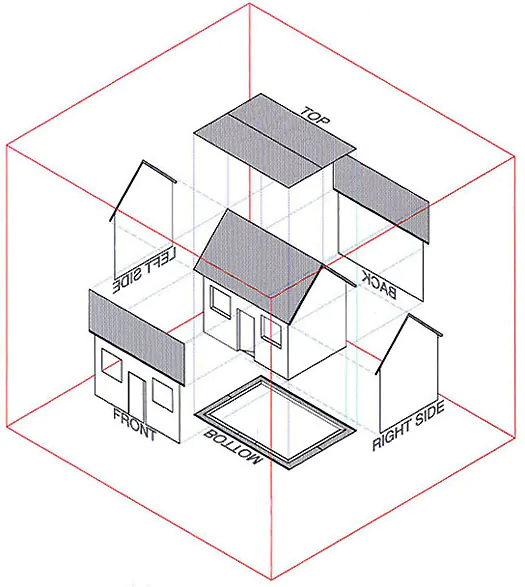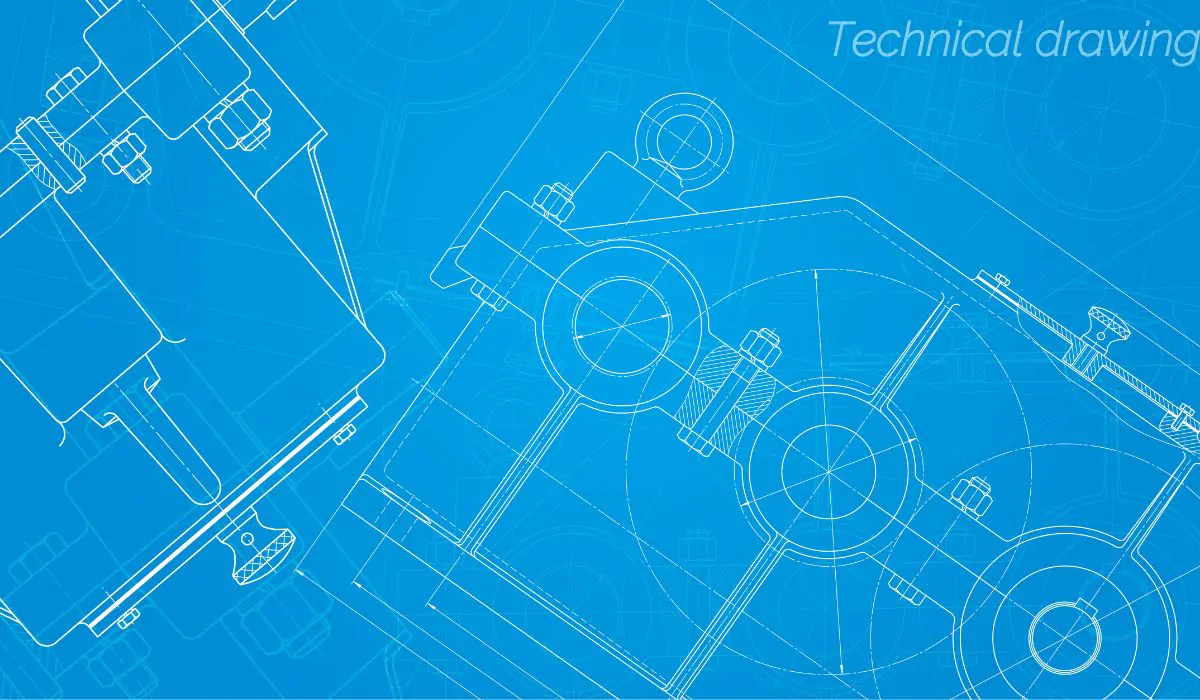In the realm of engineering, manufacturing, and design, technical drawing stands as a cornerstone, facilitating communication and precision in translating ideas into tangible creations. From the traditional tools of the past to the advanced software of today, it has evolved to meet the demands of modern innovation. In this blog, we will learn the depths of technical drawing, exploring its various types, techniques, and applications.
What is Technical Drawing?
Technical drawing, also known as drafting or engineering Design, serves as a visual language for conveying complex information related to designs, specifications, and instructions. It acts as a bridge between engineers, designers, and manufacturers, providing a detailed roadmap for the creation and realisation of products, structures, and systems. Whether it’s a blueprint for a skyscraper or a schematic for an electronic circuit, it plays a crucial role in ensuring accuracy, clarity, and consistency throughout the design and production process.
Types of Technical Drawing
Orthographic Projection
Orthographic projection, the fundamental technique in technical drawing, involves representing three-dimensional objects in two dimensions. This method utilises multiple views, including front, top, side, and sectional views, to provide a comprehensive depiction of the object’s shape and dimensions. By presenting various perspectives, orthographic projection enables engineers and manufacturers to visualise and analyse the object from different angles, ensuring precise interpretation and execution.
Isometric Drawing
Isometric drawing offers a simplified yet realistic representation of three-dimensional objects. Unlike orthographic projection, which maintains strict geometric accuracy, isometric drawings depict objects at a 30-degree angle to the horizontal axes, providing an illusion of depth without distortion. This type of drawing is commonly used in architectural renderings, industrial product design, and technical illustrations, offering a visually appealing way to showcase complex structures and assemblies.
Perspective Drawing
Perspective drawing employs foreshortening and vanishing points to create realistic representations of objects as they appear in three-dimensional space. Unlike orthographic and isometric drawings, which focus on precise measurements, perspective drawings emphasise visual depth and realism. This technique is widely used in architectural visualisation, interior design, and artistic illustrations, allowing designers to convey spatial relationships and atmospheric effects with accuracy and flair.

Assembly Drawing
Assembly drawing provides a detailed overview of how individual components fit together to form a larger assembly or product. It includes exploded views, part lists, and assembly instructions to guide the construction or manufacturing process. Assembly drawings are essential for ensuring proper alignment, fit, and functionality of mechanical and structural systems, serving as a blueprint for assembly and maintenance procedures.

Electrical Schematic
Electrical Schematic Design & Drawing illustrates the connections and components of electrical circuits using standardised symbols. These drawings provide a visual guide for designing, troubleshooting, and repairing circuits in various applications, including electronics, automation, and power systems. Electrical schematics convey information such as component layout, wiring connections, and circuit functionality, enabling engineers and technicians to understand and manipulate electrical systems effectively.

Architectural Drawing
Architectural drawing encompasses a range of drawings used to design and construct buildings and structures. This includes floor plans, elevations, sections, and site plans, which communicate spatial relationships, dimensions, and aesthetic details. Architectural drawings serve as a communication tool between architects, engineers, contractors, and clients, guiding the entire building process from conception to occupancy.

Techniques and Standards
The creation of technical drawings relies on various techniques and standards to ensure accuracy, consistency, and compatibility across different industries and applications. International organisations such as the International Organization for Standardization (ISO) and the American Society of Mechanical Engineers (ASME) establish guidelines and standards for technical drawing practices.
ISO 128 provides general rules for the execution of technical drawings, applicable to mechanical engineering, construction, architecture, and shipbuilding. It defines principles for line types, dimensioning, and notation, ensuring uniformity and clarity in technical communication.
ASME Y14.5 specifies standards for dimensioning and tolerancing, crucial aspects of technical drawing that ensure proper fit, form, and function of mechanical components. These standards help prevent errors and discrepancies in manufacturing processes, enhancing efficiency and quality control.
Applications and Industries
Technical drawing finds application across various industries, from aerospace and automotive engineering to electronics and construction. aerospace engineering, they are used to design aircraft components and systems, ensuring safety, performance, and regulatory compliance.
In automotive design and manufacturing, it plays a vital role in prototyping, tooling, and production processes, guiding the development of vehicles and their components from concept to assembly line.
In electronics and electrical engineering, technical drawings facilitate the design and assembly of circuits, control systems, and electronic devices, enabling innovation and advancement in technology.
construction and architecture, it informs the planning, construction, building design & drawing and infrastructure projects, providing detailed documentation of structural, mechanical, and electrical systems.
History of Technical Drawing
It has a rich history that dates back centuries, evolving alongside advancements in science, engineering, and architecture. The roots of technical drawing can be traced to ancient civilizations such as Mesopotamia, Egypt, and Greece, where early engineers and architects used rudimentary drawings to plan and construct monumental structures like pyramids and temples.
During the Renaissance period, artists and inventors like Leonardo da Vinci pioneered the use of detailed technical sketches to explore scientific principles and engineering concepts. Da Vinci’s notebooks are renowned for their intricate diagrams and illustrations, showcasing his visionary ideas and innovations in fields ranging from anatomy to aeronautics.
In the 19th century, the Industrial Revolution brought about significant advancements in technical drawing tools and techniques. The invention of mechanical pencils, ruling pens, and precision instruments enabled engineers and draughtsman to create highly accurate and detailed drawings with unprecedented efficiency.
The 20th century witnessed the emergence of computer-aided design (CAD) software, revolutionising the way technical drawings are created, edited, and shared. CAD technology, initially developed for aerospace and automotive industries, quickly proliferated across various sectors, offering designers and engineers powerful tools for digital drafting and modelling.
Today, it continues to evolve in tandem with digital technologies, with innovations such as 3D modelling, virtual reality (VR), and augmented reality (AR) reshaping the landscape of design and visualisation. Despite these advancements, the principles of technical drawing remain rooted in precision, clarity, and communication, serving as a timeless foundation for innovation and creativity.
Future Trends in Technical Drawing
As we look ahead, several trends and developments are poised to shape the future of technical drawing:
- Integration of AI and Machine Learning: Artificial intelligence (AI) and machine learning algorithms are increasingly being incorporated into CAD software, enabling automated tasks such as dimensioning, pattern recognition, and design optimization. These intelligent features streamline the drafting process and enhance productivity, allowing designers to focus on higher-level tasks and creative problem-solving.
- Cloud-Based Collaboration Platforms: Cloud-based collaboration platforms facilitate real-time collaboration and communication among dispersed teams of designers, engineers, and stakeholders. These platforms enable seamless sharing of technical drawings, feedback exchange, and version control, fostering efficient project management and decision-making.
- Advancements in 3D Printing: The rapid advancement of 3D printing technology offers new possibilities for prototyping, manufacturing, and product development. Technical drawings play a crucial role in 3D printing workflows, providing the blueprint for creating intricate and functional objects layer by layer. As 3D printing evolves, its standards and practices will adapt to accommodate this disruptive technology.
- Incorporation of Virtual and Augmented Reality: Virtual reality (VR) and augmented reality (AR) technologies are revolutionising the way designers visualise and interact with VR and AR applications allow users to immerse themselves in virtual environments, manipulate 3D models, and simulate real-world scenarios, enhancing design comprehension and user experience.
- Sustainability and Green Design: With a growing emphasis on sustainability and environmental consciousness, its practices are evolving to prioritise eco-friendly design principles and materials.Concepts like life cycle assessment (LCA), cradle-to-cradle design, and biomimicry are influencing the conceptualization and execution of technical drawings, promoting responsible innovation and resource conservation.
Conclusion
Technical drawing is essential for turning ideas into reality in engineering, architecture, and manufacturing. Companies like Monarch Pvt. Ltd. lead the way with their commitment to innovation and excellence. By embracing new technologies and trends, they inspire progress and shape the future of technical drawing. Together, we can continue pushing boundaries and creating a brighter future for all.
FAQs
Q: What are the 5 parts of technical drawing?
A: The five main parts of a technical drawing are the title block, drawing border, main drawing (including views and details), dimensions, and annotations. These components collectively provide comprehensive information about the depicted object or structure.
Q: Is technical drawing difficult?
A: Technical drawing can be challenging initially due to its precision and requirement for attention to detail. However, with practice, patience, and proper guidance, mastering technical drawing becomes achievable for many individuals.
Q: Who uses technical drawings?
A: Engineers, architects, designers, manufacturers, and drafters extensively use technical drawings in their respective fields to convey precise information about objects and structures.
Q: What are 6 categories of technical drawing?
A: Six categories of technical drawing includes: Orthographic Projection, Isometric Projection ,Perspective Projection, Sectional Drawing. Exploded View Drawing , Schematic Diagrams
Q: Why are technical drawings important?
A: Technical drawings provide detailed visual information essential for communication, fabrication, and understanding of complex objects and structures.





